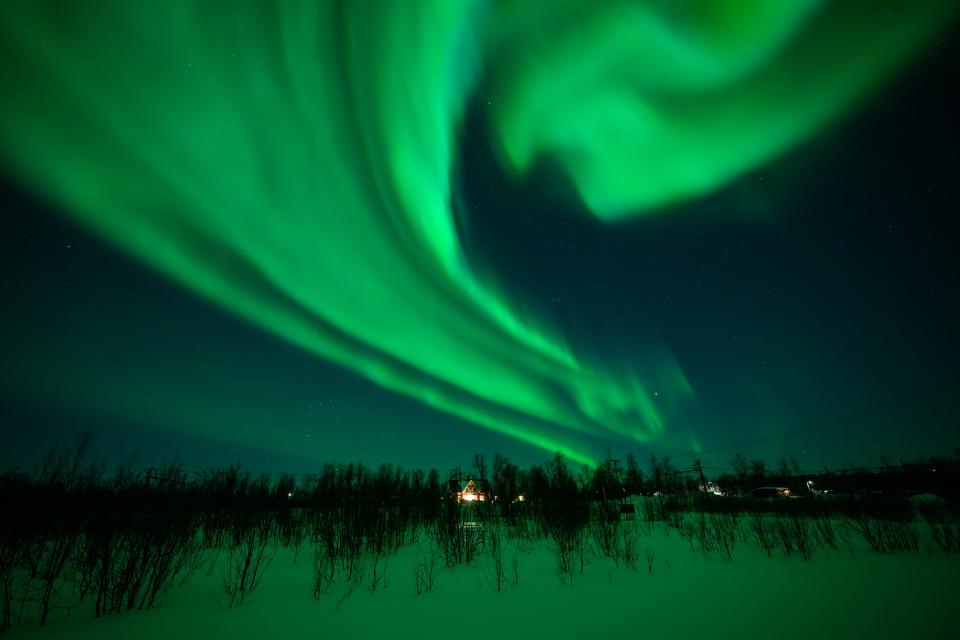Solar storm is powerful enough to disrupt communications: Why NOAA says not to worry
An uncommonly strong solar storm is hurtling toward Earth, bringing with it the power to disrupt some communications and even produce some dazzling northern lights.
The storm's impending arrival prompted the National Oceanic and Atmospheric Administration to issue a rare storm watch Thursday to warn about the possible toll it could take when the solar eruption reaches Earth as early as Friday evening.
But before you go preparing for some sort of emergency, most of those at risk of enduring the storm's wrath are power plant operators and those aboard spacecrafts. Instead, if you live anywhere in the northern part of the United States, tonight may be a good time to head outside and try to catch some auroras, NOAA officials said at a Friday news conference.
“It’s a very rare event to happen,” Shawn Dahl, a forecaster and coordinator at NOAA's Space Weather Prediction Center, said Friday. "We haven't seen this in a long time."
Here's what to know about the solar storm.
'God's Hand' seen in Milky Way: Telescope images reveal 'cloudy, ominous structure' known as 'God's Hand'
Solar flares unleash coronal mass ejections toward Earth
NOAA has been tracking the explosive bursts of radiation known as solar flares since Wednesday from a sunspot cluster that's a whopping 16 times wider than Earth.
The solar flares have unleashed at least five coronal mass ejections – clouds of plasma and charged particles – that are now making their way toward our planet at a breakneck pace, said Brent Gordon, chief of the space services branch of the Space Weather Prediction Center.
By releasing solar particles and electromagnetic radiation toward our planet, the coronal mass ejections are what drive the geometric storms toward Earth. Such electromagnetic activity will only increase as the sun continues to reach the height of its 11-year solar cycle, which NASA said is expected to be in 2025.
Forecasters use a five-level scale to measure geometric storms. At a G4, this one is just a single level away from being the most severe solar storm possible, according to NOAA. The Severe (G4) Geomagnetic Storm Watch the agency posted on Thursday marked its first since 2005.
Last December, a powerful burst of energy created the largest solar flare that NASA had detected since 2017.
A destructive solar storm in 1989 caused electrical blackouts across Quebec for 12 hours, according to NASA, plunging millions of Canadians into the dark and closing schools and businesses. The most intense solar storm on record, the Carrington Event, occurred in 1859 – sparking fires at telegraph stations and preventing messages from being sent.
The last G4 level solar storm hit Earth in March, one of only three storms of that severity observed since 2019, according to NOAA's Space Weather Prediction Center. The last time Earth was hit by a G5 storm was October 2003, when power outages were reported in Sweden and transformers were damaged in South Africa, NOAA officials said Friday.
Solar storm has potential to disrupt satellites, power grid
Don't expect anything like that this time around.
“We are not anticipating that," Dahl said Friday.
However, any solar storm of this magnitude has the potential – however remote – to interfere with our infrastructure. Anything including communications, the electric power grid, radio and satellite operations are threatened by the looming storm, which could trigger blackouts and disrupt navigation systems.
NOAA officials have seen no evidence from the past that solar storms can disrupt cellular service, Dahl said.
Dahl said NOAA has alerted satellite, grid and pipeline operators so they can prepare.
In the meantime, a NASA spacecraft orbiting about 1 million miles from Earth will help forecasters measure the solar wind and understand the exact timing and threat it poses.
But no matter what happens, rest assured that you and other people are safely protected by Earth’s magnetic field.
How to see the northern lights this weekend
The solar storm is expected to trigger the aurora borealis, the famous natural light display better known as the northern lights.
From Friday through Sunday, those in the northern half of the U.S. – potentially as far south as Alabama and northern California – have the chance of glimpsing some of the auroras amid the effects of the solar storm, according to NOAA.
If the weather is clear, the best aurora is usually visible within an hour or two of midnight, according to NOAA.

The upcoming solar storm will have particles flowing from the sun that get caught up in Earth's magnetic field, causing colorful auroras to form as they interact with molecules of atmospheric gases. Earth's magnetic field redirects the particles toward the poles through a process that produces a stunning display of rays, spirals and flickers that has fascinated humans for millennia.
NOAA also maintains an aurora dashboard that provides short-term forecasts of the northern lights.
Contributing: Doyle Rice, USA TODAY
Eric Lagatta covers breaking and trending news for USA TODAY. Reach him at [email protected]
This article originally appeared on USA TODAY: Geomagnetic solar storm threatens satellites, power grids, NOAA says
